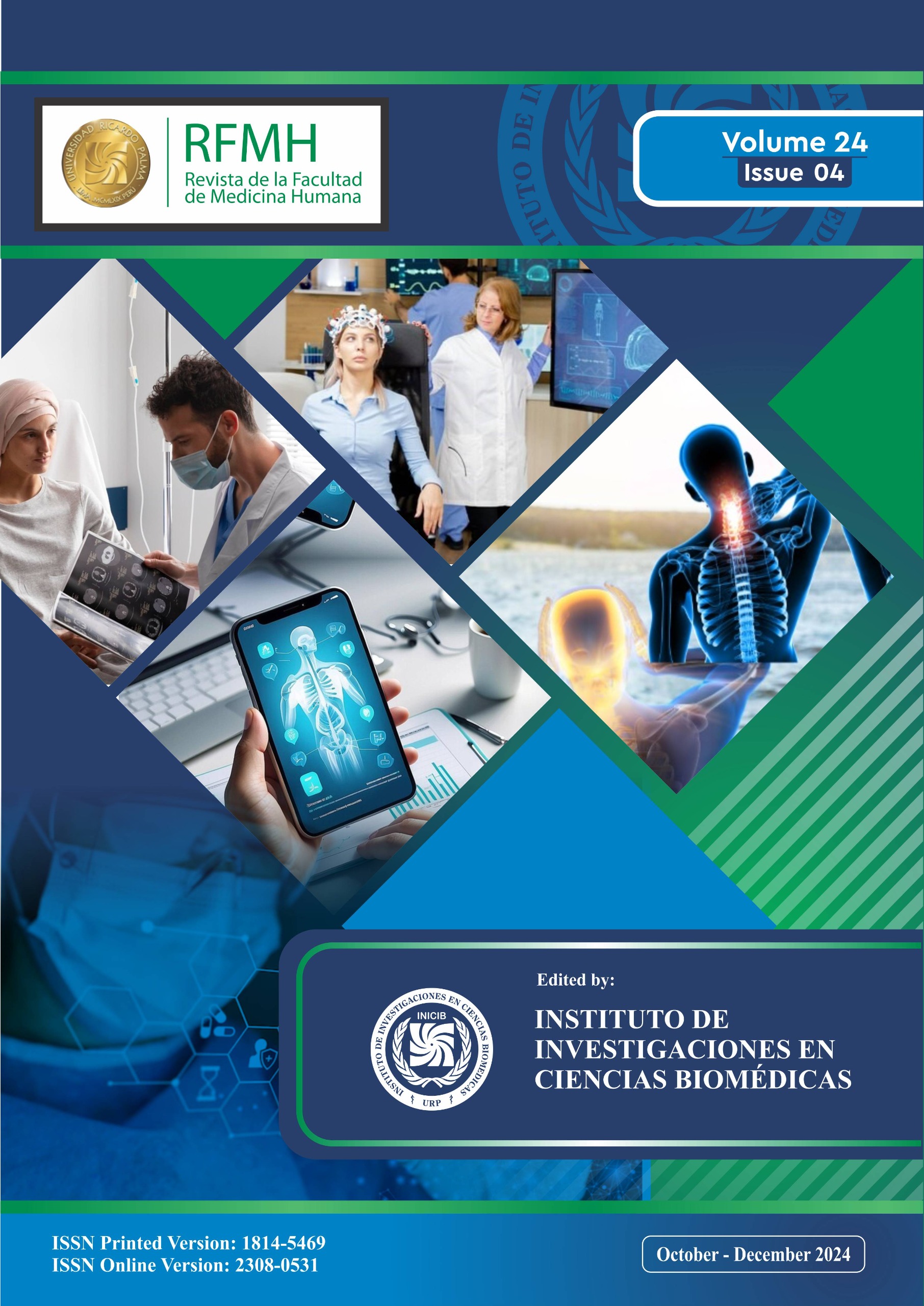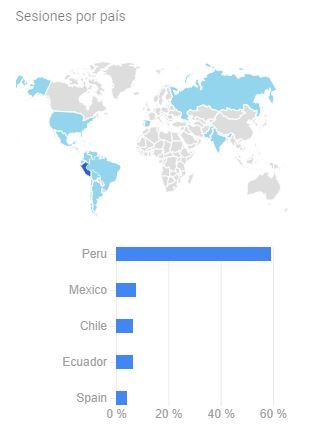Factors associated with excess body weight in university students in times of COVID-19
Factores asociados al exceso de peso corporal en estudiantes universitarios en tiempos de COVID-19
DOI:
https://doi.org/10.25176/RFMH.v23i2.5658Keywords:
obesity, overweight, sedentary lifestyle, eating habits, COVID-19Abstract
Introduction: Excess body weight affects the quality of life of millions of young people around the world. Objective: To determine the factors associated with the prevalence of overweight and obesity in university students during COVID-19, from October to December 2020. Methods: Analytical, cross-sectional research with non-experimental design. There was a population of 325 students of the professional career of medical technology and a sample of 169 students of both sexes. Body mass index and waist circumference diameter were used to calculate overweight and obesity. The associated factors were determined by means of a survey validated by expert judgment. Results: 49.1% of the students were overweight or obese, with females being the most affected. Of overweight or obese students, 59.0% were at high risk of abdominal obesity. According to eating habits, 97.6% of young people ate three or more meals per day, 81.9% consumed foods rich in carbohydrates and 54.2% consumed junk food 1 -2 times per week. In relation to sedentary lifestyle, 71.0% of students remained seated between 5 and 8 hours a day, 67.4% slept less than 7 hours a day and 57.8% did not perform any physical activity. Conclusions: The intake of food with high carbohydrate content, junk food, hours spent sleeping and sitting daily are the factors associated with the high prevalence of overweight and obesity among students during the COVID-19 period.
Downloads
References
González-Muniesa P, Mártinez-González MA, Hu FB, Després JP, Matsuzawa Y, Loos RJF, et al. Obesity. Nat Rev Dis Primers. 2017;15(3):17034. doi: https://doi.org/10.1038/nrdp.2017.34
Pajuelo RJ, Torres AL, Agüero ZR, Bernui LI. El sobrepeso, la obesidad y la obesidad abdominal en la población adulta del Perú. An. Fac. med. [Internet] 2019 [citado el 10 de marzo de 2022]; 80 (1): 21-27. doi: https://doi.org/10.15381/anales.v80i1.15863
Borjas MA, Loaiza LE, Vásquez RM, Campoverde Palma Pilar del Rocío, Arias Cevallos Karina Piedad, Chávez Cevallos Enrique. Obesidad, hábitos alimenticios y actividad física en alumnos de educación secundaria. Rev Cubana Invest Bioméd [Internet]. 2017 [citado el 10 de marzo de 2022]; 36(3):1-15. Disponible en: http://scielo.sld.cu/scielo.php?script=sci_arttext&pid=S086403002017000300008&lng=es
Acevedo VE, Palacios-Recalde C, Villamil-Pineda MF. Percepción frente a la obesidad en padres y adolescentes pertenecientes a la ciudad de Armenia, Quindío. MedUNAB [Internet]. 2020 [citado 14 de marzo de 2022];23(2):270-8. Disponible en: https://revistas.unab.edu.co/index.php/medunab/article/view/3514
Petrova D, Salamanca-Fernández E, Rodríguez M, Navarro P, Jiménez JJ, Sánchez MJ. Obesity as a risk factor in COVID-19: Possible mechanisms and implications. Aten Primaria. 2020;52(7):496-500. doi: https://doi.org/10.1016/j.aprim.2020.05.003
Bautista M, Guadarrama R, Veytia M. Prevalencia de obesidad según los indicadores: porcentaje de grasa corporal, índice de masa corporal y circunferencia de cintura . Nutr Clín Diet Hosp [Internet]. 2020 [citado 14 de marzo de 2022];40(3). Disponible en: https://revista.nutricion.org/index.php/ncdh/article/view/53
Pengpid S, Peltzer K. Prevalence of overweight/obesity and central obesity and its associated factors among a sample of university students in India. Obes Res Clin Pract. 2014;8(6):558-70. doi: https://doi.org/10.1016/j.orcp.2013.12.003
Cob E, Cohen S, Cob A. Obesidad y cáncer. Med. leg. Costa Rica [Internet]. 2018 [citado el 16 de marzo de 2022]; 35( 2 ): 45-53. Disponible en: http://www.scielo.sa.cr/scielo.php?script=sci_arttext&pid=S140900152018000200045&lng=en
Organización Mundial de la Salud. Obesidad y Sobrepeso. [Internet]. Ficha informativa de la OMS [consultado el 17 marzo de 2022]. Disponible en: https://www.who.int/es/news-room/fact-sheets/detail/obesity-and-overweight
Villca JL, Chavez-Soliz HR, Mamani Y, Arévalo MR. Correlación y concordancia de los índices circunferencia/cintura y circunferencia/talla con el índice de masa corporal. Gac Med Bol [Internet]. 2019 [citado el 17 de marzo de 2022]; 42(2): 122-126. Disponible en: http://www.scielo.org.bo/scielo.php?script=sci_arttext&pid=S101229662019000200006&lng=es
Torres-Roman JS, Helguero-Santín LM, Bazalar-Palacios J, Avilez JL, Dávila-Hernández CA. Sobrepeso y obesidad en estudiantes de medicina. ¿Un nuevo reto al sistema de salud peruano?. Salud pública Méx. 2017; 59(3): 207-208. doi: 10.21149/8277
Ninatanta JA, Núñez LA, García SA, Romaní F. Factores asociados a sobrepeso y obesidad en estudiantes de educación secundaria. Rev Pediatr Aten Primaria [Internet]. 2017 [citado el 17 de marzo de 2022]; 19(75): 209-21. Disponible en: http://scielo.isciii.es/scielo.php?script=sci_arttext&pid=S113976322017000400003&lng=es
Tarqui-Mamani C, Álvarez-Dongo D, Espinoza-Oriundo P, Sanchez-Abanto J. Análisis de la tendencia del sobrepeso y obesidad en la población peruana. Rev Esp Nutr Hum Diet. 2017; 21(2): 137-147. doi: https://doi.org/10.14306/renhyd.21.2.312
Anusha K, Hettiaratchi UPK, Athiththan LV, Perera PPR. Inter-relationship of serum leptin levels with selected anthropometric parameters among a non-diabetic population: a cross-sectional study. Eat Weight Disord. 2019 Jun;24(3):551-556. doi: https://doi.org/10.1007/s40519-017-0413-x
Molano-Tobar NJ, Vélez-Tobar RA, Molano-Tobar DX. Correlación entre índice de masa corporal, circunferencia de cintura y riesgo cardiovascular en jóvenes escolares de Popayán, Colombia. 2019; 21(3): 354-362. doi: https://doi.org/10.29375/01237047.2674
Pajuelo J, Sánchez J, Álvarez D, Tarqui C, Bustamante A. La circunferencia de la cintura en adolescentes del Perú. An. Fac. med.2016;77(2):111-116. doi: https://doi.org/10.15381/anales.v77i2.11814
López A, Vacio MÁ. La etapa universitaria y su relación con el sobrepeso y la obesidad. Revista Digital Universitaria (RDU). 2020; 21(5): 1-9. doi: https://doi.org/10.22201/cuaieed.16076079e.2020.21.5.7
López A, Vacio MÁ. La etapa universitaria y su relación con el sobrepeso y la obesidad. Revista Digital Universitaria (RDU). 2020; 21(5): 1-9. doi: https://doi.org/10.22201/cuaieed.16076079e.2020.21.5.7
Sogari G, Velez-Argumedo C, Gómez MI, Mora C. College Students and Eating Habits: A Study Using An Ecological Model for Healthy Behavior. Nutrients. 2018;10(12):1-16. doi: https://doi.org/10.3390/nu10121823
Durán S, Crovetto M, Espinoza V, Mena F, Oñate G, Fernández M et al. Caracterización del estado nutricional, hábitos alimentarios y estilos de vida de estudiantes universitarios chilenos: estudio multicéntrico. Rev. méd. Chile [Internet]. 2017 [citado el 19 de marzo de 2022];145(11): 1403-11. Disponible en: http://www.scielo.cl/scielo.php?script=sci_arttext&pid=S0034-98872017001101403&lng=es
Higuera-Sainz JL, Pimentel-Jaimes JA, Mendoza-Catalán GS, Rieke-Campoy U, Ponce de León G, Camargo-Bravo A. El consumo de alcohol como factor de riesgo para adquirir sobrepeso y obesidad. Ra Ximhai. [Internet]. 2017 [citado el 19 de marzo de 2022]; 13 (2): 53-62. Disponible en: https://www.redalyc.org/pdf/461/46154510004.pdf
Monteiro LZ, Varela AR, Lira BA, Contiero LC, Carneiro MLA, Souza P, et al. Weight status, physical activity and eating habits of young adults in Midwest Brazil. Public Health Nutr. 2019;22(14):2609-2616. doi: https://doi.org/10.1017/S1368980019000995
González-Zapata L, Carreño-Aguirre C, Estrada A, Monsalve-Álvarez J, Álvarez LS. Exceso de peso corporal en estudiantes universitarios según variables sociodemográficas y estilos de vida. Rev. chil. nutr. [Internet]. 2017 [citado el 19 de marzo de 2022]; 44( 3 ): 251-261. Disponible en: http://www.scielo.cl/scielo.php?script=sci_arttext&pid=S071775182017000300251&lng=es
García WF. Sedentarismo en niños y adolescentes: Factor de riesgo en aumento. RECIMUNDO [Internet]. 2019 [citado el 19 de marzo de 2022];3(1):1602-24. Disponible en: https://www.recimundo.com/index.php/es/article/view/449
Durán-Aguero S, Fernández-Godoy E, Fehrmann-Rosas P, Delgado-Sánchez C, Quintana-Muñoz C, Yunge-Hidalgo W, et al. Fewer hours of sleep associated with increased body weight in chilean university nutrition students. Rev Peru Med Exp Salud Pública [Internet]. 2016 [citado el 20 de marzo de 2022]; 33 (2): 264-8. Disponible en: https://pubmed.ncbi.nlm.nih.gov/27656925/

Downloads
Published
How to Cite
Issue
Section
License
Copyright (c) 2023 Revista de la Facultad de Medicina Humana

This work is licensed under a Creative Commons Attribution 4.0 International License.





























